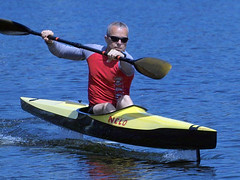How does the hydrofoil kayak work?
By Einar Rasmussen

The Flyak has two T-foils. One main foil and one front foil. The front foil is also a rudder.
The Flyak has no flaps or any other mechanisms that "sense" the surface to keep the Flyak level.
About one chord length under the surface the lifting ability of a hydrofoil decreases. This effect makes it possible to simply "lean" the foils up against the surface to keep the kayak level.

The front foil lifts first, until it is just under the surface. Then the main foil lifts the hull out of the water. The kayaker can easily control how high he will fly by increasing or decreasing the speed. When paddling faster, the main foil lifts the hull higher and at the same time tilts the hull forwards. This reduces the angle of attack, which in turn allows the kayaker to paddle faster.
The cruising speed is about 15% higher than the take-off speed, and the top speed is about 30% higher than the take-off speed.
Against and Olympic K1
To increase the lift and to make the Flyak go straight, we use winglet plates on the wingtips.
The total weight of the kayaker and hull, and the desired speed, dictate the area of the foil pair. If you want to go 5 % faster, simply make the foils 10 % shorter.
There is no reason why a pair of foils with a lift/drag coefficient of 25 or more cannot be made. Therefore, in the future, we may see times belowone minute on F1 500m men.

http://foilkayak.com/